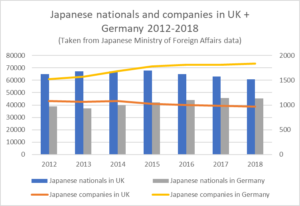The American/British language barrier through Japanese eyes
I visited Japan last year, to conduct a couple of training sessions for the subsidiaries of British companies on how to work effectively with their UK headquarters. Listening to the issues brought up by the Japanese employees, and also having heard the perspectives on those issues from the UK side, I realised yet again how often a language barrier is at the heart of many misunderstandings.
But it is not the obvious language barrier between the very different languages of Japanese and English. It is the language barrier between American English and British English, which is more rooted in cultural differences than linguistic differences.
Not only were the employees at these British subsidiaries taught American English at their Japanese schools, but several had also lived in the US or worked for American companies. British companies hired them because they assumed their linguistic ability and experience would make it easier for them to work in a multinational.
As many of the Japanese employees pointed out, however, the British and the Japanese are similar in the way they are so vague and indirect in giving direction and feedback, particularly negative feedback. “I can’t tell whether my British colleagues are angry or not”, said one Japanese participant. “I assume they are, when their emails are very long”.
The British were praised for making an effort to understand, forgiving bad English and being courteous, even when they were senior to the Japanese employee. Germans and Americans were seen as rather less gentle and standing more on their dignity. Those British who had experience of working in Asia were able to express themselves more clearly and slowly, but other British were very talkative, yet not at all clear in what they were trying to say.
I explained how the British management style is consultative and casual – preferring to give a vague, general guidance and ask team members for their input. Whereas the US leadership style is built for speed – setting targets, standardising reporting and directing individuals on what to do.
A Japanese manager, fluent in American English who had been working for American multinationals previously, was very frustrated that he kept having to repeat himself in emails, because of the lack of clear responses from the UK. “Don’t they understand what I am asking for or are they deliberately ignoring me?”
We agreed that the solution to this might be to have agreed timeframes for responses and processes on how to communicate urgency, negative feedback and whether a request had been understood and was being worked on.
I thought back to my early days at Mitsubishi Corporation, where we communicated by telex, even though email was available. The good thing about telexes was that there was a standardised way to write them, using simple, clear English which every new employee was trained in.
I wonder whether British and Japanese multinationals might need to introduce something similar, for email communication, to overcome their mutually polite, vague, miscommunications.
This article was originally published in Japanese in the Teikoku Databank News on 12th June 2019
For more content like this, subscribe to the free Rudlin Consulting Newsletter. 最新の在欧日系企業の状況については無料の月刊Rudlin Consulting ニューズレターにご登録ください。
Read More LinkedIn
LinkedIn YouTube
YouTube
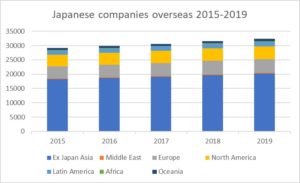
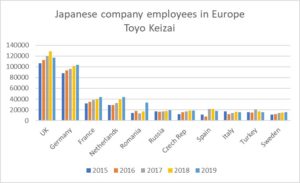 Within Europe, the number of people employed by Japanese companies rose 18% from 2015 to 2019. Those countries where the number of Japanese company employees has fallen are countries where there has been a rise in populism, civic unrest and political risk. UK employee numbers fell 9% 2018-9 (the first decline since at least 2015), Spanish employee numbers fell 19% 2018-9, Hungary’s fell 18%, Turkey’s 10%, Poland and Italy also showed small decreases in employee numbers.
Within Europe, the number of people employed by Japanese companies rose 18% from 2015 to 2019. Those countries where the number of Japanese company employees has fallen are countries where there has been a rise in populism, civic unrest and political risk. UK employee numbers fell 9% 2018-9 (the first decline since at least 2015), Spanish employee numbers fell 19% 2018-9, Hungary’s fell 18%, Turkey’s 10%, Poland and Italy also showed small decreases in employee numbers.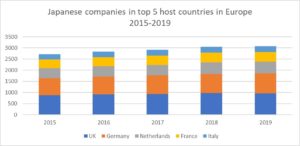 The number of Japanese companies in the UK has fallen by 1% 2018-9, from 972 to 966, the first drop since at least 2015, having risen 11% 2015-2018. France also saw a 2% drop in the number of Japanese companies, even though employee numbers are up. Germany attracted a 4% increase in Japanese companies from 2018-9, having risen 13% 2015-8. Netherlands had a 1% increase 2018-9 (13.5% 2015-8) and Italy had a 2% rise in Japanese companies 2018-9, and an increase of 11.8% 2015-8.
The number of Japanese companies in the UK has fallen by 1% 2018-9, from 972 to 966, the first drop since at least 2015, having risen 11% 2015-2018. France also saw a 2% drop in the number of Japanese companies, even though employee numbers are up. Germany attracted a 4% increase in Japanese companies from 2018-9, having risen 13% 2015-8. Netherlands had a 1% increase 2018-9 (13.5% 2015-8) and Italy had a 2% rise in Japanese companies 2018-9, and an increase of 11.8% 2015-8.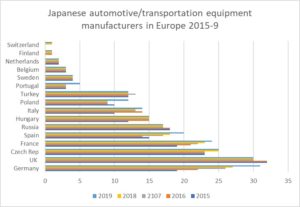 The Japanese automotive sector is of course the sector being most carefully watched for Brexit impact. Japanese automotive manufacturers are continuing to set up overseas – the total number globally has increased 10% in 2019 on 2015. And “despite” the EU-Japan EPA, 15 more Japanese transportation equipment manufacturers set up in Europe in 2019, a 20% cumulative increase on 2015. Of the 15 new companies, 4 are in Germany, 3 in Poland, 2 in Spain, 2 in Portugal, 1 in France, 1 in Italy, 1 in Slovakia and 1 mystery one. This means Germany now hosts more automotive/transportation equipment companies than the UK – 31 to the UK’s 30.
The Japanese automotive sector is of course the sector being most carefully watched for Brexit impact. Japanese automotive manufacturers are continuing to set up overseas – the total number globally has increased 10% in 2019 on 2015. And “despite” the EU-Japan EPA, 15 more Japanese transportation equipment manufacturers set up in Europe in 2019, a 20% cumulative increase on 2015. Of the 15 new companies, 4 are in Germany, 3 in Poland, 2 in Spain, 2 in Portugal, 1 in France, 1 in Italy, 1 in Slovakia and 1 mystery one. This means Germany now hosts more automotive/transportation equipment companies than the UK – 31 to the UK’s 30.